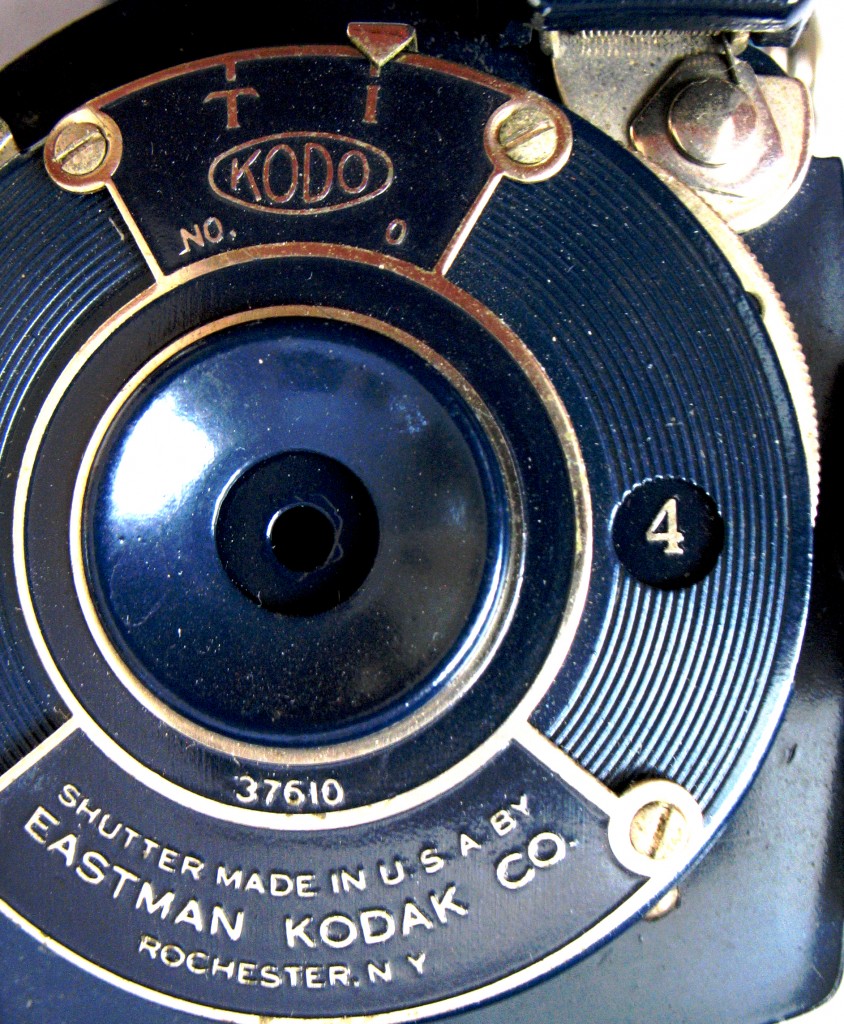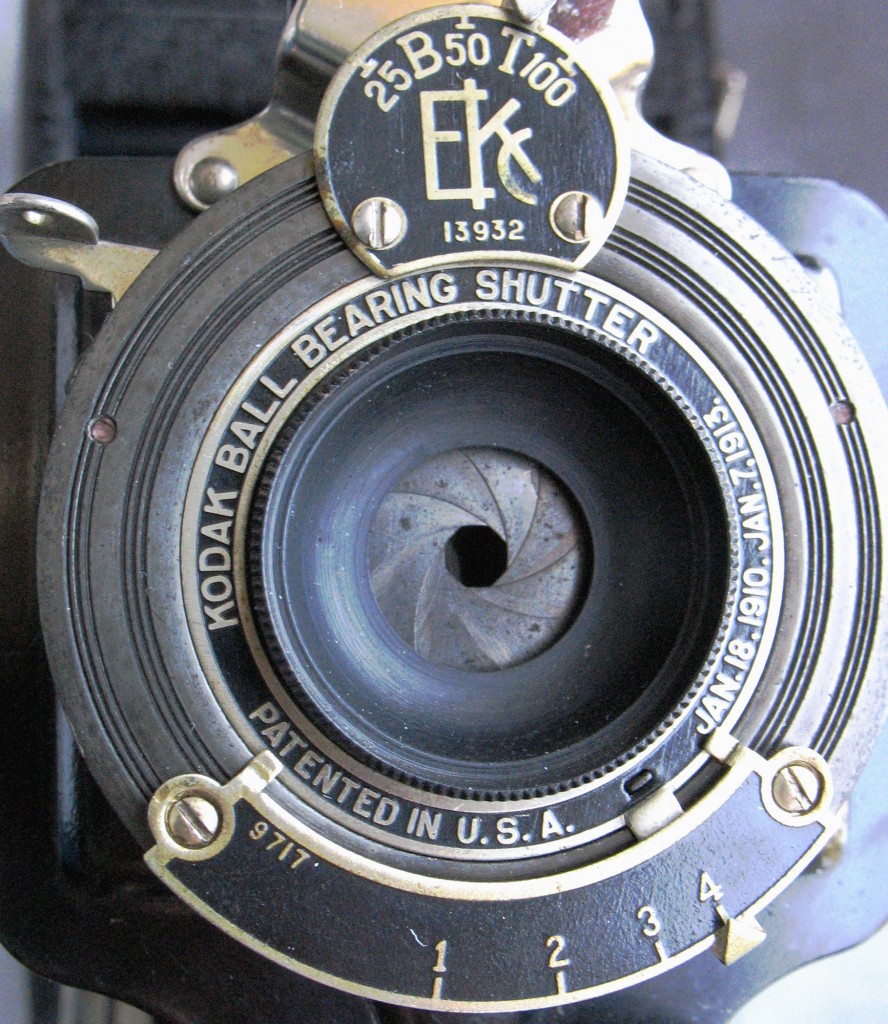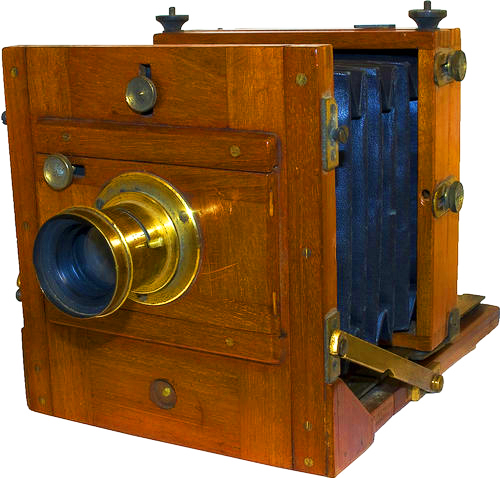
E & T Underwood 1886 “Instanto” Camera
Note: Excellent optical diagrams of the viewfinders described here are available on the Early Photography site and in Camerapedia. See reference list.
Ever since the invention of the camera, designers have grappled with the problem of accurately viewing the image before the film is exposed. Early cameras, such as the above 1886 Instanto tailboard camera, lacked any form of independent viewfinder, employing the rear ground glass focusing screen as the only means of composing the image. This arrangement worked in the days when cameras were large, heavy, bulky, and largely restricted to studio work.
Once dry plates and roll film became available, the camera moved out of the studio, and a quicker and more convenient method of previewing the image was required. In the early 1900s, this was typically done using a small reflecting Watson-type viewfinder with a ground glass screen, as seen on this 4×5 Rochester Optical Pony Premo:
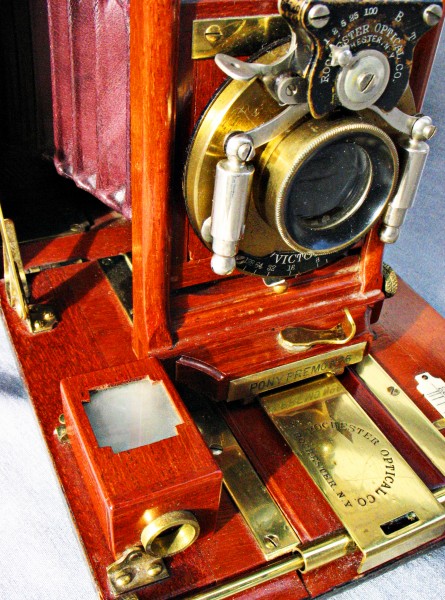
Watson-Type Ground Glass Reflective Finder on Rochester Optical 4×5 Pony Premo
The Watson finder consisted of a positive front lens, projecting onto the top ground glass screen via a 45 degree mirror, an image that was upright but reversed left to right. Unfortunately, the image thus obtained was dim and difficult to see under even moderately bright conditions. This brightly-colored hydrangea on a table is very difficult to see when viewed through the Premo’s Watson viewfinder even though the finder was protected from direct sunlight:
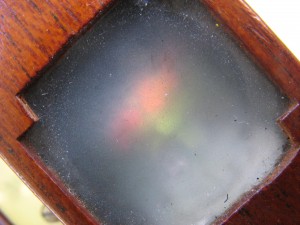
Watson Finder Image
The dim Watson finder was rapidly disappearing by 1910, to be replaced by the two-lens “Brilliant” finder; the latter was standard equipment in the consumer-level camera market until the late 1930s. Similar to the Watson finder, the brilliant finder possesses a second and larger positive lens in place of the ground glass screen. The resulting images, like those from the Watson, were upright but reversed left to right
Some of the larger brilliant finders were quite good, with a flip-up hood to shield the lens from stray light, and gearing to rotate the frame mask when the camera was rotated. Unfortunately, these are typically found on larger cameras requiring film sizes that
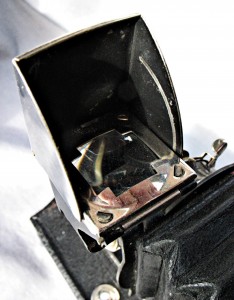
915 Kodak Brilliant Finder with Popup Hood
are no longer available. Those found on cameras using 120 film, including my favourite 1928 No. 1 Kodak, tend to be quite small and difficult to use in dim light or darkness. Using one today requires careful head placement, and many of the
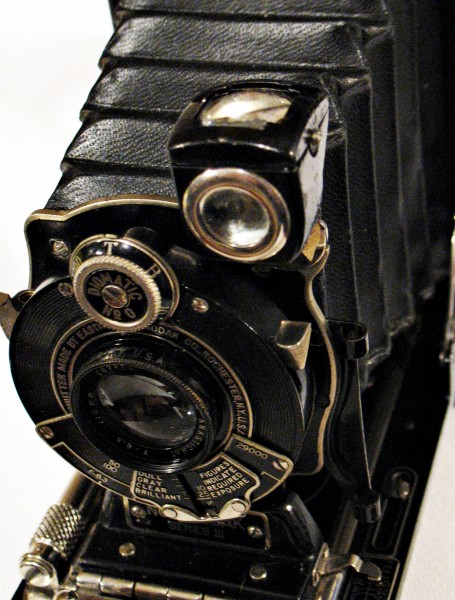
Brilliant Finder, 1928 No. 1 Kodak
mirrored coatings have suffered with age. Although much quality work, including night and low light photography, can be done with these cameras, such small brilliant finders are slow to use, and and are virtually useless for moving objects.
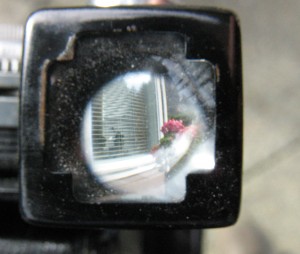
Small 1928 Kodak Brilliant Finder: Much Careful Head Movement Needed to Center Image
One solution to this problem before the 1930s was the wire frame finder, present on the majority of small 6×9 and 9×12 cm plate cameras, but relatively uncommon on roll film cameras. This typically consisted of a small viewing window, serving as the eyepiece, that unfolded from the back of the camera, and a large, flip-out wire frame attached to the front standard. Although lacking parralax correction, these were quick to deploy and easy to use for moving objects. On the plate cameras, the wire frame finder was typically accompanied by a small brilliant finder. For closeup work and exact framing of stationary objects, focusing could be accomplished on the ground glass, making the small plate camera an extremely compact and portable package capable of precision work and considerable flexibility.
Wire frame finders were found on only a few of the classic roll film cameras. Models with a wire finder include the earliest Voigtlander Bessa, and some Certo cameras:
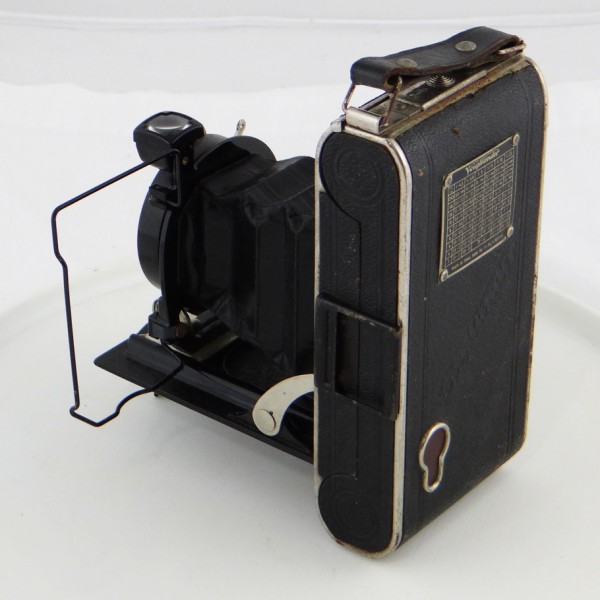
Original Model Voigtlander Bessa with Wire Frame Finder
With the advent of faster emulsions, action photography – race cars, baseball players, or rapidly-moving grandchildren – for the nonprofessional photographer became possible. Consequently, the need arose for a viewfinder that could be used more quickly and conveniently for mobile subjects: the eye level finder.
The majority of eye level finders from the 1930s to the 1960s represent variants of one of three types: the simple frame finder, the telescopic finder, and the Albada finder. During the early part of this period (1930s and early 1940s) these finders were mounted on top of the camera, typically consisting of flip-up front and rear elements.
The simplest of these finders was the rudimentary, direct vision metal frame finder. This consisted of two pop-up metal masks, the larger in front and and the smaller in the rear, with no lens elements in either. As seen on this Zeiss Ikonta, this arrangement was simple, cheap, and moderately accurate:
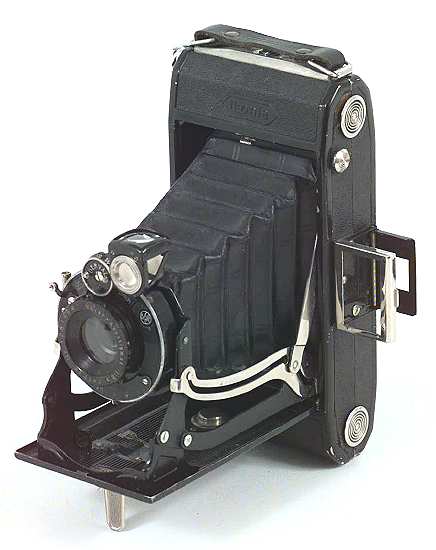
Zeiss Ikon 520-15 with Top-Mounted Simple Frame Finder
The main disadvantage of the simple frame finder is the fact that the rear (ocular) element is out of focus and difficult to visualize when the eye is adjusted for distant subjects. With roll film cameras, where the distance between the front and rear frames is limited to the width of the camera body, the out-of-focus rear frame significantly limits the accuracy of the finder. With the larger front-to-back frame distances found with the Graphic or small plate camera, the metal and wire frame finders can be very accurate.
Telescopic finders, initially appearing as top-mounted pop-up finders with lenses in the front and rear frames, consist of a negative (plano-concave) lens at the front, accompanied by a positive rear eyepiece lens. Galileo designed a telescope using the reverse of this optical arrangement; consequently these are frequently referred to as Reversed Galilean Finders. They are simple to use and produce an unreversed image of moderate brightness.
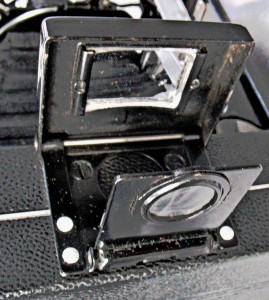
Flip-up Reversed Galilean Telescopic Finder, Kodak 620 Camera, mid-1930s
A major advance in viewfinder technology came with the introduction in 1932 of van Albada’s reflecting frame finder, or Albada Finder, which addressed the problems of eye position effects and out-of-focus frames. Consisting of a reversed Galilean finder with a field of view greater than that of the lens, the Albada Finder has the rear surface of the concave front objective partially silvered, reflecting the image of a framing line engraved around the eyepiece lens. As seen through the eyepiece, this reflected frame line is visible at any level of focus, and appears superimposed on the subject, representing the true field of view of the lens. Having the viewfinder frame larger than the len’s field of view allows visualization of moving objects coming into the image field, thus facilitating action photography. The Albada concept provided the basis for later finders displaying frames for multiple focal length lenses as well as exposure data. The best and most functional example of the traditional, Albada-type, top-mounted folding finder is found on the British Ensign 820 and 16-20 cameras
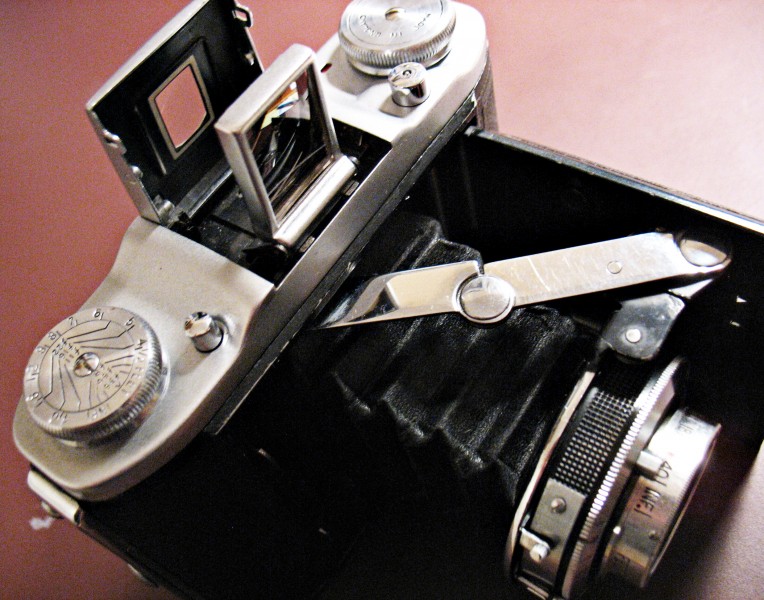
Ensign 16-20 with Albada Finder. Note the engraved finder outline on the inside of the eyepiece.
Beginning in the late 1940s, the viewfinder began to be incorporated into the top plate assembly of the camera. Initially, this took the form of a small, enclosed telescopic finder attached to the top plate, as with this Retina I:
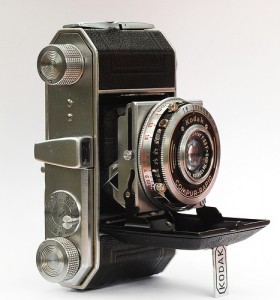
Kodak Retina Type I, circa 1935-50. Note attached telescopic finder.
Later, the telescopic finder became integrated into the upper housing, which came to extend over the entire upper body, incorporating a combined telescopic finder and rangefinder, as seen in this Voigtlander Bessa II from the 1950s:
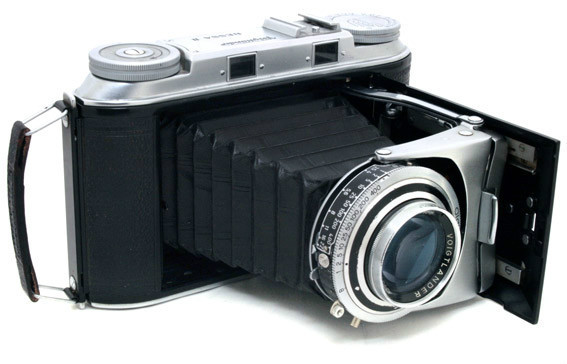
Voigtlander Bessa II. Note viewfinder and rangefinder windows incorporated into the top plate.
Incorporating the finder into the top plate of the camera streamlined the mechanism and allowed for integration with a coupled rangefinder, both significant advances. Unfortunately, this arrangement, which works well with the short lenses of folding 35mm cameras, is less satisfactory with the longer bellowsof medium format roll film cameras using 120 film in the 6×9 cm format. While the top-mounted, flip-up finders of the earlier generation of roll film cameras provided an unrestricted view of the subject, cameras with body-incorporated finders such as the Bessas have the lower quarter of the field of view obscured by the lens and bellows due to the lower position of the finder. This results from the longer bellows required by the 100-105 mm focal length lens used by the 6×9 cm format. Despite the sleeker appearance of the camera, this is annoying and can at times hamper composition.
Overall, my experience suggests that the most functional and accurate of the finders in 6×9 cm vintage roll film cameras are the Albada finders on the Ensign cameras, and the large, wire frame finders on compact plate cameras and the 6×9 cm Baby Graphic. The flip-up, top-mounted telescopic finders on roll film cameras from the 1930s are capable of quick and accurate work, as are the body-mounted finders from the 1940s and 1950s – as long as the lens and bellows do not obscure part of the field. As noted above, waist level brilliant finders on cameras from 1915 to 1940 are slow to use and significantly less accurate – yet they are part of the charm and challenge of using a truly old camera!
References:
Camerapedia. “Viewfinders.” http://camerapedia.wikia.com/wiki/Viewfinder.
Early Photography web site, “View-finders,View-meters.” http://www.earlyphotography.co.uk/site/entry_M22-9.html.
Ray, S. Applied Photographic Optics: Lenses and Photographic Systems for Photography. Focal Press, Oxford, 3rd edition, 2002.
APPENDIX: Original patent application for Van Albada finder, 1923
![US1678493[1]_Page_1](https://throughavintagelens.com/wp-content/uploads/2013/04/US16784931_Page_11.jpg)
![US1678493[1] Page 2 JPEG](https://throughavintagelens.com/wp-content/uploads/2013/04/US16784931-Page-2-JPEG1.jpg)
![US1678493[1]_Page_3](https://throughavintagelens.com/wp-content/uploads/2013/04/US16784931_Page_31.jpg)



